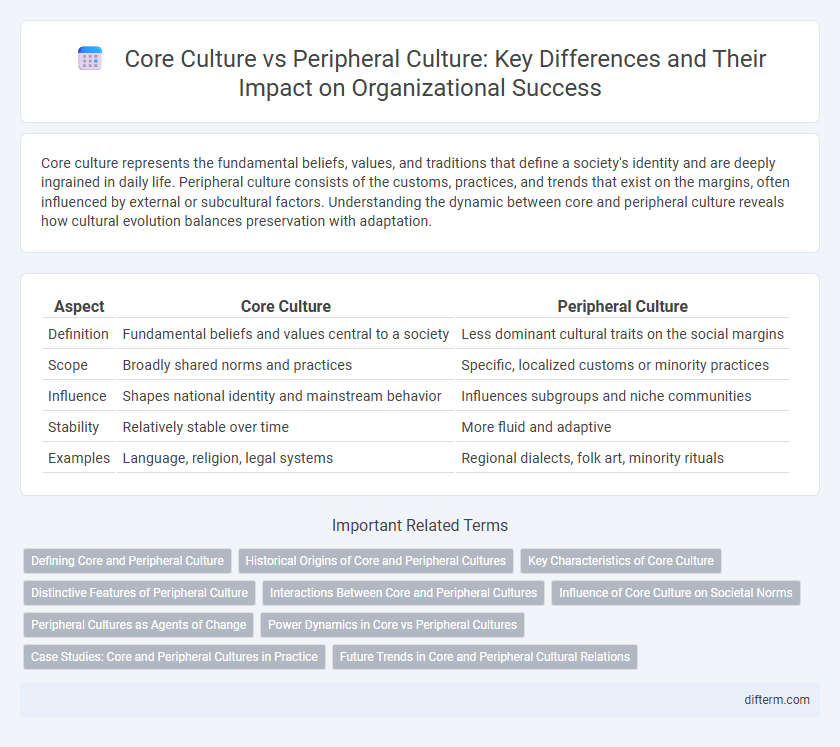Core culture represents the fundamental beliefs, values, and traditions that define a society's identity and are deeply ingrained in daily life. Peripheral culture consists of the customs, practices, and trends that exist on the margins, often influenced by external or subcultural factors. Understanding the dynamic between core and peripheral culture reveals how cultural evolution balances preservation with adaptation.
Table of Comparison
| Aspect | Core Culture | Peripheral Culture |
|---|---|---|
| Definition | Fundamental beliefs and values central to a society | Less dominant cultural traits on the social margins |
| Scope | Broadly shared norms and practices | Specific, localized customs or minority practices |
| Influence | Shapes national identity and mainstream behavior | Influences subgroups and niche communities |
| Stability | Relatively stable over time | More fluid and adaptive |
| Examples | Language, religion, legal systems | Regional dialects, folk art, minority rituals |
Defining Core and Peripheral Culture
Core culture consists of fundamental beliefs, values, and practices that form the foundation of a society's identity, shaping its worldview and social norms. Peripheral culture includes the more flexible, variable elements such as trends, fashions, and diverse customs that exist on the margins and often evolve rapidly. Understanding the distinction between core and peripheral culture is essential for analyzing how cultural stability and change coexist within communities.
Historical Origins of Core and Peripheral Cultures
Core cultures originate from ancient civilizations with long-standing traditions and influential social institutions that shape dominant societal values. Peripheral cultures emerge from smaller, localized groups often influenced by core cultures through trade, conquest, or migration, leading to cultural diffusion and hybridization. Historical records highlight examples such as the Mediterranean basin, where Greek and Roman core cultures profoundly impacted surrounding peripheral societies.
Key Characteristics of Core Culture
Core culture encompasses the fundamental beliefs, values, and norms that shape a society's identity and guide behavior across generations. It is deeply embedded in language, religion, and shared historical experiences, providing members with a collective sense of belonging and purpose. Core culture remains stable over time, influencing social institutions and reinforcing cultural continuity.
Distinctive Features of Peripheral Culture
Peripheral culture exhibits distinctive features such as limited influence on mainstream societal values and practices, often maintaining unique traditions that resist widespread assimilation. These cultures tend to thrive in geographic or social margins, preserving identity through localized customs, dialects, and rituals. Their resilience highlights diversity within broader cultural systems, emphasizing cultural variation over homogenization.
Interactions Between Core and Peripheral Cultures
Interactions between core and peripheral cultures shape societal dynamics by facilitating cultural exchange and adaptation. Core cultures often influence peripheral cultures through dominant norms, values, and practices, while peripheral cultures contribute unique traditions and innovations that enrich the core. This bidirectional interaction drives cultural evolution, fostering diversity and resilience within societies.
Influence of Core Culture on Societal Norms
Core culture shapes societal norms by establishing fundamental beliefs, values, and practices that define a community's identity. This dominant cultural framework influences laws, social behaviors, and everyday interactions, creating a cohesive social order. Peripheral cultures often adapt or respond to these core norms, reflecting the dynamic interplay between central and marginal cultural elements.
Peripheral Cultures as Agents of Change
Peripheral cultures act as dynamic agents of change by challenging dominant norms and introducing innovative practices that reshape mainstream society. Their unique perspectives foster cultural diversity and promote social evolution through adaptation and resistance. Embracing peripheral cultures enhances creativity and drives transformation within global cultural landscapes.
Power Dynamics in Core vs Peripheral Cultures
Power dynamics in core cultures often centralize authority within dominant social groups, reinforcing established hierarchies and control over resources. Peripheral cultures experience more diffuse power structures, frequently shaped by external influences and limited access to political or economic leverage. This contrast in power distribution impacts cultural expression, social mobility, and identity formation across both cultural spheres.
Case Studies: Core and Peripheral Cultures in Practice
Core cultures, such as the dominant cultural group in a nation, shape societal values and norms, while peripheral cultures often represent minority communities with distinct traditions and lifestyles. Case studies of multicultural societies like Canada reveal how core cultures influence policy-making and national identity, whereas peripheral cultures contribute unique perspectives that enrich social cohesion. Examining interactions between core and peripheral cultures in urban settings highlights challenges of integration, cultural preservation, and the negotiation of cultural power dynamics.
Future Trends in Core and Peripheral Cultural Relations
Future trends in core and peripheral cultural relations indicate increasing hybridization as global communication technologies enable peripheral cultures to influence core cultural narratives more significantly. Shifts in economic power and demographic changes contribute to the rise of peripheral cultures entering mainstream cultural discourse, challenging traditional cultural hierarchies. This dynamic interaction fosters the emergence of new cultural expressions and identities, reshaping global cultural frameworks and promoting more inclusive cultural exchanges.
core culture vs peripheral culture Infographic

 difterm.com
difterm.com